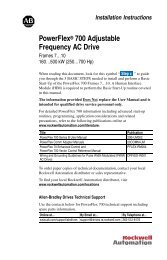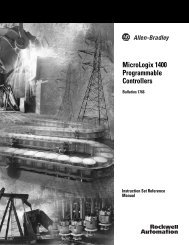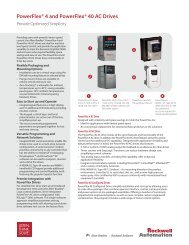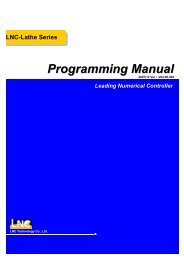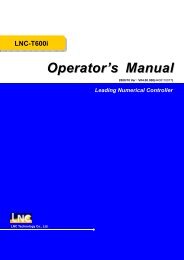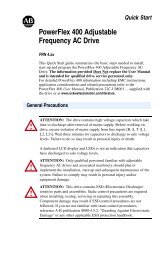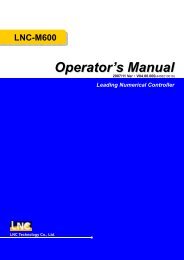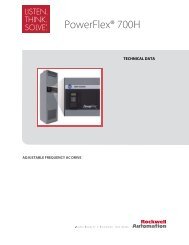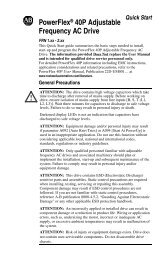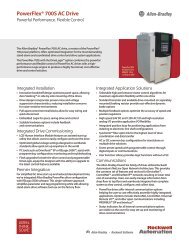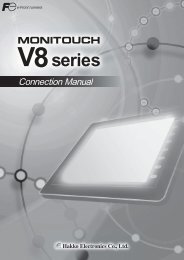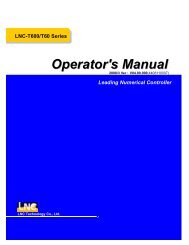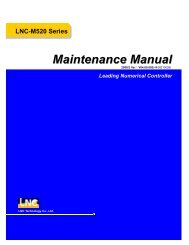1766-UM002 - Rockwell Automation
1766-UM002 - Rockwell Automation
1766-UM002 - Rockwell Automation
Create successful ePaper yourself
Turn your PDF publications into a flip-book with our unique Google optimized e-Paper software.
MicroLogix 1400<br />
Embedded Web<br />
Server<br />
Bulletin <strong>1766</strong> Controllers<br />
User Manual
Important User Information<br />
Solid state equipment has operational characteristics differing from those of<br />
electromechanical equipment. Safety Guidelines for the Application,<br />
Installation and Maintenance of Solid State Controls (publication SGI-1.1<br />
available from your local <strong>Rockwell</strong> <strong>Automation</strong> sales office or online at<br />
http://literature.rockwellautomation.com) describes some important<br />
differences between solid state equipment and hard-wired electromechanical<br />
devices. Because of this difference, and also because of the wide variety of<br />
uses for solid state equipment, all persons responsible for applying this<br />
equipment must satisfy themselves that each intended application of this<br />
equipment is acceptable.<br />
In no event will <strong>Rockwell</strong> <strong>Automation</strong>, Inc. be responsible or liable for<br />
indirect or consequential damages resulting from the use or application of<br />
this equipment.<br />
The examples and diagrams in this manual are included solely for illustrative<br />
purposes. Because of the many variables and requirements associated with<br />
any particular installation, <strong>Rockwell</strong> <strong>Automation</strong>, Inc. cannot assume<br />
responsibility or liability for actual use based on the examples and diagrams.<br />
No patent liability is assumed by <strong>Rockwell</strong> <strong>Automation</strong>, Inc. with respect to<br />
use of information, circuits, equipment, or software described in this manual.<br />
Reproduction of the contents of this manual, in whole or in part, without<br />
written permission of <strong>Rockwell</strong> <strong>Automation</strong>, Inc., is prohibited.<br />
Throughout this manual, when necessary, we use notes to make you aware<br />
of safety considerations.<br />
WARNING<br />
Identifies information about practices or circumstances that can cause<br />
an explosion in a hazardous environment, which may lead to personal<br />
injury or death, property damage, or economic loss.<br />
IMPORTANT<br />
ATTENTION<br />
SHOCK HAZARD<br />
Identifies information that is critical for successful application and<br />
understanding of the product.<br />
Identifies information about practices or circumstances that can lead<br />
to: personal injury or death, property damage, or economic loss.<br />
Attentions help you identify a hazard, avoid a hazard, and recognize<br />
the consequence<br />
Labels may be on or inside the equipment, such as a drive or motor, to<br />
alert people that dangerous voltage may be present.<br />
BURN HAZARD<br />
Labels may be on or inside the equipment, such as a drive or motor, to<br />
alert people that surfaces may reach dangerous temperatures.<br />
<strong>Rockwell</strong> <strong>Automation</strong>, Allen-Bradley, SLC 5/02, SLC 5/03, PLC-5, MicroLogix, SLC 500, RSLogix, RSLinx, RSLogix 500, RSLogix<br />
Micro and TechConnect are trademarks of <strong>Rockwell</strong> <strong>Automation</strong>, Inc.<br />
Trademarks not belonging to <strong>Rockwell</strong> <strong>Automation</strong> are property of their respective companies.
Table of Contents<br />
MicroLogix 1400 Embedded Web<br />
Server<br />
Use Data Views to Access<br />
Controller Data<br />
Chapter 1<br />
How to Use This Chapter . . . . . . . . . . . . . . . . . . . . . . . . . . . 3<br />
Typical Applications . . . . . . . . . . . . . . . . . . . . . . . . . . . . . . . 3<br />
Browser Requirements . . . . . . . . . . . . . . . . . . . . . . . . . . . . . 3<br />
Connect the MicroLogix 1400 controller to the Network . . . . . 4<br />
Navigate the MicroLogix 1400 Controller . . . . . . . . . . . . . . . . 6<br />
Chapter 2<br />
How to Use This Chapter . . . . . . . . . . . . . . . . . . . . . . . . . . . 7<br />
Overview of Data Views . . . . . . . . . . . . . . . . . . . . . . . . . . . . 7<br />
Change an Access Group . . . . . . . . . . . . . . . . . . . . . . . . . . . 8<br />
Data View Page . . . . . . . . . . . . . . . . . . . . . . . . . . . . . . . . 9<br />
Change Data Table Files . . . . . . . . . . . . . . . . . . . . . . . . . . . 10<br />
How to Change a Data File Type . . . . . . . . . . . . . . . . . . 10<br />
Disable Web View . . . . . . . . . . . . . . . . . . . . . . . . . . . . . . . 12<br />
Chapter 3<br />
Monitor Diagnostics How to Use This Chapter . . . . . . . . . . . . . . . . . . . . . . . . . . 15<br />
MicroLogix 1400 Controller Diagnostics . . . . . . . . . . . . . . . . 15<br />
Network Status . . . . . . . . . . . . . . . . . . . . . . . . . . . . . . . . . . 18<br />
Chapter 4<br />
Administrative Settings Server Settings . . . . . . . . . . . . . . . . . . . . . . . . . . . . . . . . . . 21<br />
Customize Server Settings. . . . . . . . . . . . . . . . . . . . . . . . 21<br />
Chapter 5<br />
User Management How to Use This Chapter . . . . . . . . . . . . . . . . . . . . . . . . . . 23<br />
User Accounts and Privilege Classes. . . . . . . . . . . . . . . . . . . 23<br />
Configure Access Limits for Web Pages . . . . . . . . . . . . . . . . 24<br />
Recover with Unknown Password . . . . . . . . . . . . . . . . . . . . 26<br />
Chapter 6<br />
Simple Web Pages Device Information . . . . . . . . . . . . . . . . . . . . . . . . . . . . 28<br />
Ethernet Configuration . . . . . . . . . . . . . . . . . . . . . . . . . . 28<br />
Diagnostic Information. . . . . . . . . . . . . . . . . . . . . . . . . . 29<br />
Data Table Memory Map . . . . . . . . . . . . . . . . . . . . . . . . 31<br />
Chapter 7<br />
User Provided Pages HTML Pages . . . . . . . . . . . . . . . . . . . . . . . . . . . . . . . . . . . . 33<br />
Generating Custom Data Table Monitor Pages . . . . . . . . . . . 35<br />
Index<br />
1 Publication <strong>1766</strong>-<strong>UM002</strong>A-EN-P - November 2008
2 Table of Contents<br />
Notes:<br />
Publication <strong>1766</strong>-<strong>UM002</strong>A-EN-P - November 2008
Chapter 1<br />
MicroLogix 1400 Embedded Web Server<br />
How to Use This Chapter<br />
<strong>Rockwell</strong> <strong>Automation</strong> offers enhanced MicroLogix 1400 controllers for<br />
your EtherNet/IP control systems so you can monitor data remotely<br />
via web pages.<br />
This chapter shows how you can use a MicroLogix 1400 controller in<br />
your control system.<br />
Topic<br />
Page<br />
Typical Applications 3<br />
Browser Requirements 3<br />
Connect the MicroLogix 1400 controller to the Network 4<br />
Navigate the MicroLogix 1400 Controller 6<br />
Typical Applications<br />
With the MicroLogix 1400 controller, you can access controller and<br />
control system data with different and remote access applications.<br />
With a web browser, you can easily monitor live MicroLogix 1400<br />
controller data remotely.<br />
With the MicroLogix 1400 controller, you can access Simple web page<br />
view, and custom-designed User Provided page views. Simple web<br />
pages use only HTML tags and are useful in limited-communication<br />
environments where radio modems are used.<br />
Browser Requirements<br />
You can access the MicroLogix 1400 controllers only with Internet<br />
Explorer 6.0, Opera 9.23 , FireFox 2.0.0.14, or Safari 3.0.4, or higher .<br />
To access data view pages, the browser requires Javascript and XML<br />
support.<br />
The supported display sizes start from 640 x 480. Smaller display sizes<br />
also work but require scrolling to view the information.<br />
3 Publication <strong>1766</strong>-<strong>UM002</strong>A-EN-P - November 2008
4 MicroLogix 1400 Embedded Web Server<br />
Connect the MicroLogix<br />
1400 controller to the<br />
Network<br />
1. Connect the module to<br />
the network.<br />
Connect the MicroLogix 1400 controller to the Ethernet network. The<br />
RJ-45 connector is on the left-hand side of the module.<br />
44592<br />
2. Obtain an IP address. By default, the MicroLogix 1400 controller is BOOTP enabled. If you<br />
connect the MicroLogix 1400 controller to a network that has a<br />
For more information, see<br />
BOOTP server, that server will assign an IP address to the MicroLogix<br />
MicroLogix1400 Programmable<br />
1400 controller and the LCD screen of the MicroLogix 1400 controller<br />
Controllers User Manual<br />
<strong>1766</strong>-UM001.<br />
will display BOOTP IP address.<br />
If your network does not have a BOOTP server, use one of the<br />
methods described in the MicroLogix 1400 Programmable Controllers<br />
User Manual <strong>1766</strong>-UM001 to assign an IP address to the MicroLogix<br />
1400 controller.<br />
Publication <strong>1766</strong>-<strong>UM002</strong>A-EN-P - November 2008
MicroLogix 1400 Embedded Web Server 5<br />
3. Access the Home page of<br />
the web server.<br />
In your web browser’s Address box, enter the IP address of the<br />
MicroLogix 1400 controller. The Home page is displayed.<br />
Specify the IP address of the<br />
MicroLogix 1400 controller in the<br />
Address window of your web<br />
browser.<br />
This is the controller’s Home page.<br />
4. Log into the web server. Many of the features of the MicroLogix 1400 controller require you to<br />
log in with appropriate access. If you select a feature, such as Data<br />
Views, the MicroLogix 1400 controller prompts you to enter your user<br />
name and password. The user name is either administrator or guest.<br />
The password is ml1400 for administrator and guest for guest.<br />
Default Access<br />
User Name: administrator or guest<br />
(case sensitive)<br />
Password:<br />
(ml1400 for administrator, guest for guest)<br />
You can set up as many as 10 user accounts. Each account can have<br />
read, write, or administrator access. For more information, see User<br />
Management on page 23.<br />
Publication <strong>1766</strong>-<strong>UM002</strong>A-EN-P - November 2008
6 MicroLogix 1400 Embedded Web Server<br />
Navigate the MicroLogix<br />
1400 Controller<br />
You navigate the web server’s web pages by using the navigation<br />
panel on the left of the screen. There are also tabs across the top you<br />
can click to navigate the folders containing documents.<br />
Tabs across the top match the documents<br />
within a folder, as shown in the left<br />
navigation panel.<br />
Click folders to open and close<br />
additional levels of information.<br />
Click a document to display a<br />
web page showing specific<br />
information.<br />
Publication <strong>1766</strong>-<strong>UM002</strong>A-EN-P - November 2008
Chapter 2<br />
Use Data Views to Access Controller Data<br />
How to Use This Chapter<br />
The MicroLogix 1400 controller provides access to the controller data<br />
table files. This chapter shows you how to set up views of data table<br />
files.<br />
Topic<br />
Page<br />
Overview of Data Views 7<br />
Change an Access Group 8<br />
Monitor Data Views and Data Table File 9<br />
Change Data Table Files 10<br />
Disable Web View 12<br />
Overview of Data Views<br />
Data views give you the ability to read controller data via a browser<br />
interface. The MicroLogix 1400 controller provides web pages that let<br />
you configure a set of files (a data view) that can be read.<br />
A data view consists of an HTML file and an XML file with data file<br />
information. The HTML file is in a readable ASCII format. It contains<br />
the File Name, File Type, # of Element, and Access Group.<br />
7 Publication <strong>1766</strong>-<strong>UM002</strong>A-EN-P - November 2008
8 Use Data Views to Access Controller Data<br />
Change an Access Group<br />
Each data view contains a group of files that you want to monitor.<br />
Each MicroLogix 1400 controller can support multiple data views. One<br />
browser supports only one data view, so if you want to look at many<br />
data views, you need to run a corresponding number of browsers.<br />
You change an access group from the Data Views → New Data View page.<br />
1. From the Access Group pull-down menu of the given data table<br />
file, choose one of the following access group types:<br />
• Administrator (all access)<br />
• Write (read/write access only)<br />
• Read (read access only)<br />
2. Choose Administrator, Write, or Read from the Access Group<br />
pull-down menu to change a file's access group.<br />
3. Click Apply to change an access group for the data table file<br />
you specified.<br />
Publication <strong>1766</strong>-<strong>UM002</strong>A-EN-P - November 2008
Use Data Views to Access Controller Data 9<br />
Monitor Data Views and<br />
Data Table File<br />
Use the Data Views → Data Views page to view existing data table files.<br />
Click the file name to view the data within a data table file.<br />
Data View Page<br />
The Data Views page displays a list of the data table files, their type,<br />
and size in elements for a connected MicroLogix 1400, as shown in<br />
the following example.<br />
Each file contains a hyperlink that takes you to the specific Data<br />
Views page for that file. When you click a particular file, the Data<br />
Views page appears, displaying the contents of the data table file you<br />
selected.<br />
Publication <strong>1766</strong>-<strong>UM002</strong>A-EN-P - November 2008
10 Use Data Views to Access Controller Data<br />
The available and default display formats depend on the data type of<br />
the file.<br />
Click Back to display the previous page. To refresh the data view,<br />
click Update.<br />
Change Data Table Files<br />
The data in the Data File Types such as Binary, Integer, Long, Float,<br />
and String can be changed. The Binary, Integer, and Long types<br />
support all the Display formats. You can edit Binary types by bit, and<br />
the Octal, Decimal, and Hexadecimal types by element. A user<br />
account with either Write or Administrator access level can change the<br />
Data Table Files. When you click N7 in Data Views, Data Writable<br />
appears beside a Data File Type (Integer here) as shown below.<br />
How to Change a Data File Type<br />
In the steps that follow, a Binary type is assumed.<br />
Publication <strong>1766</strong>-<strong>UM002</strong>A-EN-P - November 2008
Use Data Views to Access Controller Data 11<br />
1. Change Display As to Binary, then the following screen appears.<br />
2. Double-click the data you want to change, then the background<br />
color turns pink.<br />
3. Enter a value and either press Enter or click an area in the<br />
screen, then a confirmation window appears.<br />
Publication <strong>1766</strong>-<strong>UM002</strong>A-EN-P - November 2008
12 Use Data Views to Access Controller Data<br />
4. Click OK to change the value.<br />
The following screen appears when the value is successfully<br />
saved into the server.<br />
If the following screen appears, the value is not saved and the<br />
value returns to the original value.<br />
If you want to change the data in Decimal, click the pull-down menu<br />
to change the Display As to Decimal and follow the steps described.<br />
The steps also apply to the String type.<br />
Disable Web View<br />
Using RSLogix 500/RSLogix Micro V8.10 or higher, you can disable<br />
individual data files from being viewed via any web browser by<br />
selecting the data file’s properties page and checking the Web View<br />
Disable checkbox as shown below. Any data file property changes<br />
must be made offline and downloaded to the processor or later.<br />
Publication <strong>1766</strong>-<strong>UM002</strong>A-EN-P - November 2008
Use Data Views to Access Controller Data 13<br />
Publication <strong>1766</strong>-<strong>UM002</strong>A-EN-P - November 2008
14 Use Data Views to Access Controller Data<br />
Notes:<br />
Publication <strong>1766</strong>-<strong>UM002</strong>A-EN-P - November 2008
Chapter 3<br />
Monitor Diagnostics<br />
How to Use This Chapter<br />
This chapter describes the diagnostics presented on the user-oriented<br />
diagnostic pages.<br />
Topic<br />
Page<br />
MicroLogix 1400 Controller Diagnostics 15<br />
Diagnostic Overview 16<br />
Network Settings 17<br />
Network Status 18<br />
MicroLogix 1400 Controller<br />
Diagnostics<br />
The MicroLogix 1400 controller provides four diagnostic pages of<br />
user-oriented diagnostics.<br />
Topic<br />
Overview of the current configuration of the<br />
MicroLogix 1400 controller<br />
Summary of the network settings<br />
configured for the MicroLogix 1400<br />
controller<br />
Ethernet statistics<br />
Web page<br />
Diagnostics → Diagnostic Overview<br />
Diagnostics → Network Settings<br />
Diagnostics → Network Status<br />
15 Publication <strong>1766</strong>-<strong>UM002</strong>A-EN-P - November 2008
16 Monitor Diagnostics<br />
Diagnostic Overview<br />
The Diagnostics → Diagnostic Overview page presents a summary of<br />
the current configuration and overall status of the MicroLogix 1400<br />
controller. This summary includes:<br />
• Ethernet link.<br />
• Ethernet Connections.<br />
This field<br />
Ethernet Link<br />
Port Speed<br />
Port Duplex<br />
Auto negotiate Status<br />
Ethernet Connections<br />
Current Ethernet Connections<br />
Incoming Ethernet Connections<br />
Outgoing Ethernet Connections<br />
Ethernet Connection Limit<br />
Specifies<br />
whether the Ethernet port is operating at 10 Mbps or 100 Mbps<br />
whether the Ethernet port is operating at half duplex or full duplex<br />
whether the port speed and duplex mode were determined via autonegotiation or whether<br />
they were manually configured<br />
current number of active connections<br />
current number of incoming connections<br />
current number of outgoing ethernet connections<br />
maximum number of Ethernet incoming/outgoing connections<br />
Publication <strong>1766</strong>-<strong>UM002</strong>A-EN-P - November 2008
Monitor Diagnostics 17<br />
Network Settings<br />
The Diagnostics → Network Settings page presents a summary of the<br />
current Ethernet configuration for MicroLogix 1400. This summary<br />
includes:<br />
• Ethernet address details.<br />
Any fields not configured remain blank.<br />
This field<br />
Network Interface<br />
Ethernet Address (MAC)<br />
IP Address<br />
Subnet Mask<br />
Default Gateway<br />
Primary Server Name<br />
Secondary Server Name<br />
Domain Name<br />
Specifies<br />
Ethernet (MAC) address of the controller<br />
IP address for the controller<br />
subnet mask for the controller<br />
gateway address for the controller<br />
DNS server names, if using DNS addressing<br />
domain name for the web server module, if using DNS addressing<br />
Publication <strong>1766</strong>-<strong>UM002</strong>A-EN-P - November 2008
18 Monitor Diagnostics<br />
Network Status<br />
The Diagnostics → Network Status page presents a summary of the<br />
status of communication activity on the Ethernet network. This<br />
summary includes:<br />
• Ethernet network configuration.<br />
• packets sent and received over the Ethernet network.<br />
• frames sent and received over the Ethernet network.<br />
This field<br />
Interface Counters<br />
Rx Octets<br />
Tx Octets<br />
Rx Packets<br />
Tx Packets<br />
Command Sent<br />
Command Received<br />
Replies Sent<br />
Replies Received<br />
Replies Sent with error<br />
Replies Received with error<br />
Replies Timed Out<br />
Media Counters<br />
Single Collisions<br />
Specifies<br />
Octets received on the Ethernet interface<br />
Octets sent on the Ethernet interface<br />
Packets received on the Ethernet interface<br />
Packets sent on the Ethernet interface<br />
Command sent on the Ethernet interface<br />
Command received on the Ethernet interface<br />
Replies sent on the Ethernet interface<br />
Replies received on the Ethernet interface<br />
Outbound packets that contain errors<br />
Inbound packets that contain errors<br />
No reply within a specified time period<br />
Successfully transmitted frames which experienced exactly one collision<br />
Publication <strong>1766</strong>-<strong>UM002</strong>A-EN-P - November 2008
Monitor Diagnostics 19<br />
This field<br />
Multiple Collisions<br />
Deferred Transmissions<br />
Late Collisions<br />
Excessive Collisions<br />
MAC Transmit Errors<br />
Carrier Sense Errors<br />
MAC Receive Errors<br />
CRC Errors<br />
Specifies<br />
Successfully transmitted frames which experienced more than one collision<br />
Frames for which first transmission attempt is delayed because the medium is busy<br />
Number of times a collision is detected later than 512 bit-times into the transmission of<br />
a packet<br />
Frames for which transmission fails due to excessive collisions<br />
Frames for which transmission fails due to an internal MAC sublayer transmit error<br />
Times that the carrier sense condition was lost or never asserted when attempting to<br />
transmit a frame<br />
Frames for which reception on the Ethernet interface failed due to an internal MAC<br />
sublayer receive error<br />
Frames for which CRC error is detected<br />
Publication <strong>1766</strong>-<strong>UM002</strong>A-EN-P - November 2008
20 Monitor Diagnostics<br />
Notes:<br />
Publication <strong>1766</strong>-<strong>UM002</strong>A-EN-P - November 2008
Chapter 4<br />
Administrative Settings<br />
Server Settings<br />
Select Administrative Settings > Server Settings to customize some of<br />
the server settings of the module, as well as back up the file system on<br />
the web server module. You can:<br />
• customize server settings, including web home page.<br />
Customize Server Settings<br />
Select Administrative Settings > Server Settings to customize the web<br />
home page.<br />
In The Field<br />
Web Home Page<br />
Take This Action<br />
Select a home page of MicroLogix 1400 controller.<br />
If Default Home Page is selected, the current web page is shown.<br />
If User #1 Web Page is selected, the first user provided page is shown. For information,<br />
see User Provided Pages on page 33.<br />
If Simple Web Page is selected, the simple web page is shown.<br />
For default home page, enter the IP address in the URL address bar, for example,<br />
http://192.168.0.10/index.htm.<br />
21 Publication <strong>1766</strong>-<strong>UM002</strong>A-EN-P - November 2008
22 Administrative Settings<br />
Notes:<br />
Publication <strong>1766</strong>-<strong>UM002</strong>A-EN-P - November 2008
Chapter 5<br />
User Management<br />
How to Use This Chapter<br />
This chapter describes how to configure user access levels to different<br />
information on the module.<br />
Topic<br />
Page<br />
User Accounts and Privilege Classes 23<br />
Configure Access Limits for Web Pages 24<br />
Create User Accounts 25<br />
Recover with Unknown Password 26<br />
By assigning user accounts with different access levels, you can<br />
manage which users have access to view network configuration or<br />
have access to view and change data views.<br />
Several pages on the MicroLogix 1400 controller, such as diagnostics<br />
pages and data views pages, have default access protection. Before<br />
accessing these pages, you must authenticate your access by entering<br />
a user name and password. The module displays the log-in box when<br />
you access these web pages.<br />
IMPORTANT<br />
Once authenticated, you do not have to re-enter a user name or<br />
password when accessing subsequent pages. You must close<br />
your browser to log out.<br />
The default user name is administrator with password 'ml1400' or<br />
guest with password 'guest'.<br />
IMPORTANT<br />
It is strongly recommended that you change the password for<br />
the default Administrator account.<br />
User Accounts and<br />
Privilege Classes<br />
The MicroLogix 1400 controller supports multiple user accounts, each<br />
with a user name and password. Each user account is configured for<br />
one of these access levels:<br />
• Administrator (all access)<br />
• Write (read/write access only)<br />
• Read (read access only)<br />
23 Publication <strong>1766</strong>-<strong>UM002</strong>A-EN-P - November 2008
24 User Management<br />
The access level determines which web pages the user can access.<br />
You configure access limits for individual web pages.<br />
Configure Access Limits for<br />
Web Pages<br />
Each page in the MicroLogix 1400 controller has one of these<br />
protection levels:<br />
• Administrator<br />
• Write<br />
• Read<br />
The protection levels are hierarchical. Administrator users can access<br />
Read protected pages.<br />
These pre-defined pages (those web pages that come with the<br />
MicroLogix 1400 controller) in the MicroLogix 1400 controller have<br />
these default access levels. You can change the Data View access<br />
group, if needed, with administrator privilege<br />
Web Page<br />
Home page<br />
Diagnostics pages<br />
Data Views<br />
New Data View<br />
Server Setting page<br />
User Management page<br />
Default Protection Level<br />
no protection<br />
Read protection<br />
Read protection<br />
Administrator protection<br />
Administrator protection<br />
Administrator protection<br />
Publication <strong>1766</strong>-<strong>UM002</strong>A-EN-P - November 2008
User Management 25<br />
Create User Accounts<br />
You need Administrator access to create and modify user accounts.<br />
You can create as many as 10 individual accounts. You manage<br />
accounts from the Administrative Settings → User Management → Edit<br />
Users page.<br />
In this field<br />
User ID<br />
Group<br />
Password<br />
Confirm Password<br />
Do this<br />
enter the user name for the account<br />
20 characters maximum<br />
can contain these characters: A-Z, a-z, 0-9, underscore (_), and dash<br />
(-)<br />
select Administrator, Write, or Read access for the user account<br />
enter the password for the account<br />
10 characters maximum<br />
re-enter the same password for the account<br />
IMPORTANT<br />
If you use Internet Explorer, the number of characters allowed<br />
for a user ID or password depends on how many characters<br />
“fit in the box.” Larger characters (such as “W”) take more<br />
room and reduce the total number of allowed characters.<br />
A user account with a specific previlege can access the Data<br />
corresponding to the specific access level, i.e. a user account with<br />
Read access level can not access the Data belonging to Write or<br />
Publication <strong>1766</strong>-<strong>UM002</strong>A-EN-P - November 2008
26 User Management<br />
Administrator acess group. The following screen, which shows only<br />
Read Access Group, appears when you log in with the guest account.<br />
Recover with Unknown<br />
Password<br />
Update the firmware using ControlFlash to initialize both user<br />
accounts and the access level of data view.<br />
Publication <strong>1766</strong>-<strong>UM002</strong>A-EN-P - November 2008
Chapter 6<br />
Simple Web Pages<br />
MicroLogix 1400 controllers can supply Simple Web Pages in<br />
environments where communications status is an issue. These type of<br />
web pages only support HTML tags without graphic files. You can<br />
only monitor Ethernet configurations and data tables with these type<br />
of web pages.<br />
The following topics appear on the home page main menu, as shown<br />
below:<br />
• Module Information<br />
• Ethernet Configuration<br />
• Diagnostic Information<br />
• Data Table Memory Map<br />
• User Provided Pages<br />
27 Publication <strong>1766</strong>-<strong>UM002</strong>A-EN-P - November 2008
28 Simple Web Pages<br />
Device Information<br />
The device information page displays a table with information about<br />
the Micrologix 1400 controller. The specific information displayed<br />
includes the controller model, series/revision and mode of the<br />
controller.<br />
Ethernet Configuration<br />
This page displays a table with information about the current Ethernet<br />
configuration parameters. Included are the module’s IP address, the<br />
subnet mask, gateway address, the Ethernet hardware address and<br />
whether BOOTP is enabled. Also included are the name server,<br />
Publication <strong>1766</strong>-<strong>UM002</strong>A-EN-P - November 2008
Simple Web Pages 29<br />
secondary name server and the default domain name parameters, if<br />
configured.<br />
Diagnostic Information<br />
This section gives you access to the various diagnostic information<br />
screens that are available.<br />
Publication <strong>1766</strong>-<strong>UM002</strong>A-EN-P - November 2008
30 Simple Web Pages<br />
The diagnostic screens automatically refresh using a time which is<br />
configurable by the user and defaults to 15 seconds.<br />
Data Table Memory Map<br />
The Data Table Memory Map page displays a list of the data table<br />
files, their type, and size in elements for a connected MicroLogix 1400<br />
Publication <strong>1766</strong>-<strong>UM002</strong>A-EN-P - November 2008
Simple Web Pages 31<br />
controller. To view memory maps, login with a Read access group<br />
user account.<br />
Each file contains a hyperlink that takes you to the specific Data Table<br />
Monitor page for that file. When you click on a particular file, the Data<br />
Publication <strong>1766</strong>-<strong>UM002</strong>A-EN-P - November 2008
32 Simple Web Pages<br />
Table Monitor page appears, displaying the contents of the data table<br />
file you selected.<br />
The available and default display formats depend on the data type of<br />
the file.<br />
You can change the Display format and Refresh data every xx seconds<br />
fields by entering data in the text boxes and clicking the Change<br />
Parameters button.<br />
To change the refresh data function back to the default of 15 seconds,<br />
click the Default field. To disable the refresh data function, click the<br />
Disable button.<br />
Publication <strong>1766</strong>-<strong>UM002</strong>A-EN-P - November 2008
Chapter 7<br />
User Provided Pages<br />
You can use a text editor to generate up to 8 user-provided web<br />
pages. Each page is stored in four consecutive ASCII files of the<br />
MicroLogix 1400 controller. The channel configuration feature of<br />
RSLogix 500/RSLogix Micro (version 8.10 or later) allows you to select<br />
the starting file number and the number of user pages to be stored, as<br />
shown in the following example:<br />
RSLogix 500/RSLogix Micro (version 8.10 or later) also allows you to<br />
import an HTML file from your PC to specified ASCII files in the<br />
MicroLogix 1400 controller. See page 36 for details.<br />
HTML Pages<br />
Referencing Other Pages/Servers - following are some basic<br />
considerations when referencing other pages or servers:<br />
• reference User Specified Pages in the MicroLogix 1400 controller<br />
by using the names user1.htm through user8.htm<br />
33 Publication <strong>1766</strong>-<strong>UM002</strong>A-EN-P - November 2008
34 User Provided Pages<br />
• to reference a page on the same controller, specify a URL such<br />
as /user2.htm<br />
• to reference a page on another processor, specify a URL such as<br />
http://www.xxx.yyy.zzz/user2.htm, where www.xxx.yyy.zzz is<br />
the IP address of the controller<br />
• you can reference other WWW servers and display images from<br />
other sources without affecting your usage of data table memory<br />
(except for the size of the HTTP reference)<br />
Referencing Data Table Memory - reference data table memory<br />
locations by placing custom tags into your HTML source which specify<br />
the data table location and optional formatting information. Use the<br />
following format for the custom tag:<br />
<br />
The items surrounded by {} are sometimes optional. The items<br />
surrounded by [] are always optional.<br />
You must always specify the basic file reference. Depending on which<br />
file is being referenced, file_number or file_element may be defaulted.<br />
If the file_type is I, O or S, the file_number does not need to be<br />
specified, but the file_element must be specified. If the file_type is not<br />
one of the three special files, the file_number must be specified and<br />
the file_element may default to zero (the input, output and status files<br />
have fixed file numbers).<br />
When defining your custom tag, consider the following:<br />
Tag Item<br />
#elements<br />
%format<br />
Display format<br />
defaults<br />
Fixed display<br />
formats<br />
Description<br />
If not specified, this defaults to one. If it is less than one, it also<br />
defaults to one. Each element is output using the same format<br />
(whether specified with %format or defaulted).<br />
Legal values are %d for decimal and %x for hexadecimal. The<br />
following file types allow the format to be specified<br />
• Input<br />
• Output<br />
• Status<br />
• Integer<br />
• Timer<br />
• Counter<br />
• Control<br />
• Long<br />
Input and Output file elements are output in decimal format. Status<br />
file elements are output in hexadecimal format with a leading 0x.<br />
Integer file elements are output in decimal format. Complex data<br />
types (Timer, Counter, Control, or other data types) are output as a<br />
table with bits and important words specified.<br />
Float files are always output in floating point format (“C”%g<br />
format). ASCII and STring files are always output as a null<br />
terminated text string. Binary files are always output as two binary<br />
bytes.<br />
Publication <strong>1766</strong>-<strong>UM002</strong>A-EN-P - November 2008
User Provided Pages 35<br />
HTML Examples - the following example shows an HTML code<br />
segment with a short description of what you would see on a web<br />
browser:<br />
Examples HTML Code Web Browser Displays<br />
Input image word I:0 the value of the first word of the<br />
input image table in the default<br />
format of decimal with bold type<br />
Timer T4:0 the values of the timer in T4:0 in<br />
the default format of a table<br />
Timer T4:0 the values of the three words<br />
comprising timer T4:0 in decimal<br />
with bold type<br />
N24:0 to N24:3 the values of the four words in<br />
N24:0 through N24:3 in decimal<br />
with bold type<br />
S:21 to S:23 the values of the three words in<br />
S:21 through S:23 in decimal with<br />
bold type<br />
Generating Custom Data<br />
Table Monitor Pages<br />
You can generate Custom Data Table Monitor pages with your text<br />
editor then download them to the MicroLogix 1400 controller using<br />
RSLogix 500/RSLogix Micro version 8.10 or later. The first element of<br />
the file must contain a special tag as shown here:<br />
<br />
where xx is the automatic refresh rate in seconds (01 to 99).<br />
A value outside the range defaults to a “snapshot” display.<br />
You can modify the refresh rate three different ways:<br />
• enter the desired refresh rate and press the Change button<br />
• select the Default button for a 15 second refresh<br />
• disable the refresh by selecting the Disable button<br />
Referencing Data Table Memory - the Data Table locations in the<br />
Custom Data Table Monitor are referenced by placing custom tags into<br />
the ASCII file of the processor. The format of the custom tag is:<br />
<br />
The items surrounded with {} are sometimes optional, whereas the<br />
items surrounded by [] are always optional.<br />
Publication <strong>1766</strong>-<strong>UM002</strong>A-EN-P - November 2008
36 User Provided Pages<br />
You must always specify the basic file reference. Depending on which<br />
file is being referenced, file_number or file_element may be defaulted.<br />
If the file_type is I, O or S, the file_number does not need to be<br />
specified, but the file_element must be specified. If the file_type is not<br />
one of the three special files, the file_number must be specified and<br />
the file_element may default to zero (because the input, output and<br />
status files have fixed numbers).<br />
When defining your custom tag, consider the following:<br />
Tag Item<br />
#elements<br />
%format<br />
!comment<br />
Fixed display formats<br />
Description<br />
If not specified, this defaults to one. If it is less than one,<br />
also defaults to one. Each element is output using the same<br />
format (whether specified with %format or defaulted). Any<br />
associated comment is displayed only for the first element.<br />
Legal values are %b for binary, %d for decimal, %0 for<br />
octal and %x for hexadecimal. The following file types<br />
allow the format to be specified:<br />
• Input<br />
• Output<br />
• Status<br />
• Integer<br />
All other file types are displayed in an appropriate format.<br />
Data after the exclamation point and up to the closing > is<br />
displayed in the Comment column of the monitor.<br />
Float files are always output in floating point format<br />
(“C”%g format). String files are always output as a null<br />
terminated text string. Binary files are always output as<br />
four binary nibbles. Complex data types (Timer, Counter,<br />
Control or other data files) are output as a table with bits<br />
and important words specified.<br />
Importing User Page Files to the MicroLogix 1400 Controller<br />
Use RSLogix 500/RSLogix Micro to import user page files to the<br />
MicroLogix 1400 controller ASCII files:<br />
1. In the Project folder (under the Data Files folder), right-click on<br />
the first of the block of four consecutive ASCII files where you<br />
will import the user page HTML file.<br />
2. Click on Properties.<br />
3. Click on Import HTML.<br />
4. Use the browser to locate the user page HTML file you want to<br />
import.<br />
5. Double-click on the file to select it.<br />
6. Click OK.<br />
Publication <strong>1766</strong>-<strong>UM002</strong>A-EN-P - November 2008
User Provided Pages 37<br />
7. Repeat this process for each user page file.<br />
8. When all user page files have been imported, go online with<br />
your MicroLogix 1400 controller processor.<br />
9. Select the User Provided Pages link to view the User Provided<br />
Pages menu, as shown in the following example:<br />
Click on the User Provided Page #X to display that specific page.<br />
Publication <strong>1766</strong>-<strong>UM002</strong>A-EN-P - November 2008
38 User Provided Pages<br />
Notes:<br />
Publication <strong>1766</strong>-<strong>UM002</strong>A-EN-P - November 2008
Index<br />
A<br />
access group<br />
creating 8<br />
access levels<br />
classes 23<br />
access limits<br />
configuring 24<br />
accessing<br />
typical application 3<br />
administrative settings 21<br />
Administrator access 24<br />
authentication 23<br />
B<br />
browser requirements 3<br />
C<br />
change data table files 10<br />
configure<br />
server settings 21<br />
configuring<br />
access limits 24<br />
user accounts 25<br />
connecting 4<br />
creating<br />
access group 8<br />
D<br />
data table memory map 31<br />
data views<br />
monitoring 9<br />
overview 7<br />
device information 28<br />
diagnostic information 29<br />
Diagnostic Overview 16<br />
diagnostics<br />
diagnostic overview 16<br />
Ethernet statistics 18<br />
network settings 17<br />
disable web view 12<br />
E<br />
Ethernet configuration 28<br />
G<br />
generating custom data table monitor pages<br />
35<br />
H<br />
HTML pages 33<br />
I<br />
installing 4<br />
IP address 4<br />
M<br />
MicroLogix 1100 Controller Diagnostics 15<br />
monitor diagnostics 15<br />
N<br />
navigating 6<br />
P<br />
password 23, 26<br />
R<br />
Read access 24<br />
recovering 26<br />
remote access 3<br />
requirements, browser 3<br />
S<br />
server settings 21<br />
simple web pages 27<br />
T<br />
typical applications 3<br />
U<br />
user accounts<br />
classes 23<br />
creating 25<br />
user management 23<br />
user provided pages 33<br />
W<br />
write access 5<br />
Publication <strong>1766</strong>-<strong>UM002</strong>A-EN-P - November 2008
40 Index<br />
Notes:<br />
Publication <strong>1766</strong>-<strong>UM002</strong>A-EN-P - November 2008
Pub. Title/Type MicroLogix 1400 Embedded Web Server<br />
How Are We Doing?<br />
Your comments on our technical publications will help us serve you better in the future.<br />
Thank you for taking the time to provide us feedback.<br />
You can complete this form and mail (or fax) it back to us or email us at<br />
RADocumentComments@ra.rockwell.com.<br />
Cat. No. Bulletin <strong>1766</strong> Controllers Pub. No. <strong>1766</strong>-<strong>UM002</strong>A-EN-P Pub. Date November 2008 Part No.<br />
Please complete the sections below. Where applicable, rank the feature (1=needs improvement, 2=satisfactory, and 3=outstanding).<br />
Overall Usefulness 1 2 3 How can we make this publication more useful for you?<br />
Completeness<br />
(all necessary information<br />
is provided)<br />
1 2 3 Can we add more information to help you?<br />
procedure/step illustration feature<br />
example guideline other<br />
explanation<br />
definition<br />
Technical Accuracy<br />
(all provided information<br />
is correct)<br />
1 2 3 Can we be more accurate?<br />
text<br />
illustration<br />
Clarity<br />
(all provided information is<br />
easy to understand)<br />
1 2 3 How can we make things clearer?<br />
Other Comments<br />
You can add additional comments on the back of this form.<br />
Your Name<br />
Your Title/Function<br />
Would you like us to contact you regarding your comments?<br />
Location/Phone<br />
___No, there is no need to contact me<br />
___Yes, please call me<br />
___Yes, please email me at _______________________<br />
___Yes, please contact me via _____________________<br />
Return this form to: <strong>Rockwell</strong> <strong>Automation</strong> Technical Communications, 1 Allen-Bradley Dr., Mayfield Hts., OH 44124-9705<br />
Fax: 440-646-3525 Email: RADocumentComments@ra.rockwell.com<br />
Publication CIG-CO521D-EN-P- July 2007
PLEASE FASTEN HERE (DO NOT STAPLE)<br />
Other Comments<br />
PLEASE FOLD HERE<br />
NO POSTAGE<br />
NECESSARY<br />
IF MAILED<br />
IN THE<br />
UNITED STATES<br />
PLEASE REMOVE<br />
BUSINESS REPLY MAIL<br />
FIRST-CLASS MAIL PERMIT NO. 18235 CLEVELAND OH<br />
POSTAGE WILL BE PAID BY THE ADDRESSEE<br />
1 ALLEN-BRADLEY DR<br />
MAYFIELD HEIGHTS OH 44124-9705
Notes:
Notes:
Notes:
<strong>Rockwell</strong> <strong>Automation</strong><br />
Support<br />
<strong>Rockwell</strong> <strong>Automation</strong> provides technical information on the Web to<br />
assist you in using its products. At<br />
http://support.rockwellautomation.com, you can find technical<br />
manuals, a knowledge base of FAQs, technical and application notes,<br />
sample code and links to software service packs, and a MySupport<br />
feature that you can customize to make the best use of these tools.<br />
For an additional level of technical phone support for installation,<br />
configuration and troubleshooting, we offer TechConnect Support<br />
programs. For more information, contact your local distributor or<br />
<strong>Rockwell</strong> <strong>Automation</strong> representative, or visit<br />
http://support.rockwellautomation.com.<br />
Installation Assistance<br />
If you experience a problem with a hardware module within the first<br />
24 hours of installation, please review the information that's contained<br />
in this manual. You can also contact a special Customer Support<br />
number for initial help in getting your module up and running:<br />
United States 1.440.646.3434<br />
Monday – Friday, 8am – 5pm EST<br />
Outside United<br />
States<br />
Please contact your local <strong>Rockwell</strong> <strong>Automation</strong> representative for any<br />
technical support issues.<br />
New Product Satisfaction Return<br />
<strong>Rockwell</strong> tests all of its products to ensure that they are fully<br />
operational when shipped from the manufacturing facility. However, if<br />
your product is not functioning and needs to be returned:<br />
United States<br />
Outside United<br />
States<br />
Contact your distributor. You must provide a Customer Support case<br />
number (see phone number above to obtain one) to your distributor in<br />
order to complete the return process.<br />
Please contact your local <strong>Rockwell</strong> <strong>Automation</strong> representative for<br />
return procedure.<br />
Publication <strong>1766</strong>-<strong>UM002</strong>A-EN-P - November 2008 47<br />
Copyright © 2008 <strong>Rockwell</strong> <strong>Automation</strong>, Inc. All rights reserved. Printed in the U.S.A.



